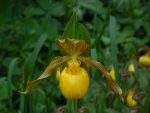 Yellow lady’s slipper is a herbaceous perennial and member of the orchid family, Orchidaceae. It is native to North America where it grows in deciduous woodlands of most of the US. Plants grow 1-2.5″ tall from a fibrous fleshy root system and has many unbranched stems bearing three or more alternate sessile leaves that are dark to yellow green. The leaves are elliptic, up to 8″ long, hairy, and with wavy margins. The central stem is hairy and carries 1 to 2 terminal flowers from late spring to early summer. Each flower as 3 petals. The lower petal is yellow with purple veins, up to 2″ long, and shaped like a pouch with an opening on top and sometimes reddish brown dots inside. The two other petals are spirally twisted, 1-3.5″ long, softly hairy, and yellowish green or brownish. Yellow lady slipper is easier to grow than other native orchids. It is sometimes listed as a variety of Cypripedium calceolus, a native of Europe and Asia, but is not grown in the US. The genus name, Cypripedium, comes from the Greek words Kypris referring to the island where Venus was worshiped, and pedilon, meaning slipper referring to the shape of the flower. The specific epithet, pubescens, is the Latin word pubens meaning downy and refers to the soft hair on various plant parts.
Yellow lady’s slipper is a herbaceous perennial and member of the orchid family, Orchidaceae. It is native to North America where it grows in deciduous woodlands of most of the US. Plants grow 1-2.5″ tall from a fibrous fleshy root system and has many unbranched stems bearing three or more alternate sessile leaves that are dark to yellow green. The leaves are elliptic, up to 8″ long, hairy, and with wavy margins. The central stem is hairy and carries 1 to 2 terminal flowers from late spring to early summer. Each flower as 3 petals. The lower petal is yellow with purple veins, up to 2″ long, and shaped like a pouch with an opening on top and sometimes reddish brown dots inside. The two other petals are spirally twisted, 1-3.5″ long, softly hairy, and yellowish green or brownish. Yellow lady slipper is easier to grow than other native orchids. It is sometimes listed as a variety of Cypripedium calceolus, a native of Europe and Asia, but is not grown in the US. The genus name, Cypripedium, comes from the Greek words Kypris referring to the island where Venus was worshiped, and pedilon, meaning slipper referring to the shape of the flower. The specific epithet, pubescens, is the Latin word pubens meaning downy and refers to the soft hair on various plant parts.
Type: Herbaceous perennial
Bloom: Terminal flowers with large yellow pouch lower petal and two spirally twisted yellowish greenor brownish lateral petals; late spring to early summer
Size: 1-2.5 h x 1″ W
Light:Partial sun to light shade
Soil:Fertile, moist to slightly dry, well-drained, neutral to slightly alkaline
Hardiness: Zones 3-8
Care: Difficult to grow
Pests and Diseases: Slugs, snails
Propagation: Division
Companion Plants: Ferns, wild bleeding heart, dogtoothed violets
Photo Credit: Wikipedia